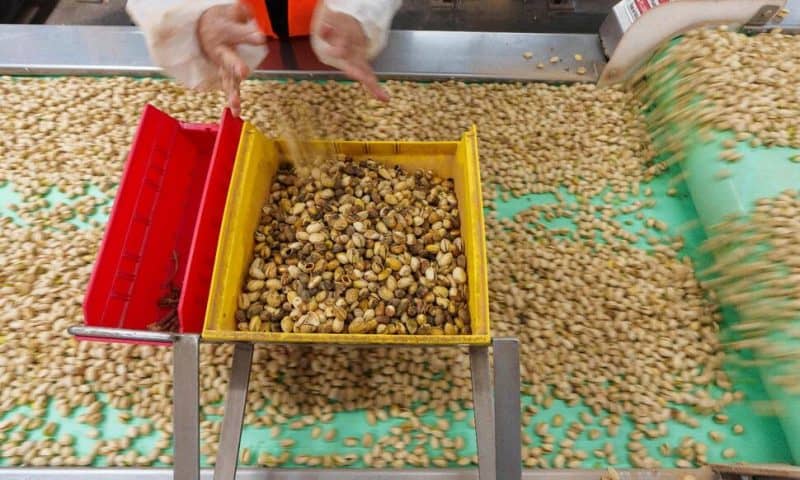California farmers have been devoting more land to pistachios, which are seen as hardier and more drought-tolerant in a state prone to dramatic swings in precipitation
LOST HILLS, Calif. — In a sprawling plant in the heart of California’s farmland, millions of shells rush down a metallic chute and onto a conveyor belt where they are inspected, roasted, packaged and shipped off to groceries around the world.
Pistachios are growing fast in California, where farmers have been devoting more land to a crop seen as hardier and more drought-tolerant in a state prone to dramatic swings in precipitation. The crop generated nearly $3 billion last year in California and in the past decade the United States has surpassed Iran to become the world’s top exporter of the nut.
“There has been an explosion over the last 10 or 15 years of plantings, and those trees are coming online,” said Zachary Fraser, president and chief executive of American Pistachio Growers, which represents more than 800 farmers in the southwestern U.S. “You are starting to see the fruit of people’s vision from 40 years ago.”
California grows more than a third of the country’s vegetables and three quarters of its fruit and nuts, according to state agricultural statistics. Pistachios have surged over the past decade to become the state’s sixth-biggest agricultural commodity in value ahead of longtime crops such as strawberries and tomatoes, the data shows.
Much of the crop is headed to China, where it is a popular treat during Lunar New Year. But industry experts said Americans also are eating more pistachios, which were rarely in grocery stores a generation ago and today are a snack food found almost everywhere. They are sold with shells or without and flavors range from salt and pepper to honey roasted.
The Wonderful Co., a $6 billion agricultural company known for brands such as Halo mandarins and FIJI Water, is the biggest name in pistachios. The company has grown pistachios since the 1980s, but it ramped up in 2015 after developing a rootstock that yields as much as 40% more nuts with the same soil and water, said Rob Yraceburu, president of Wonderful Orchards.
Now, Wonderful grows between 15% and 20% of the U.S. pistachio crop, he said. Its pistachio orchards stretch across vast tracts of dust-filled farmland northwest of Los Angeles also lined with pomegranates and dairies. The trees are shaken each fall and the nuts hauled to a massive processing facility to be be prepped for sale.
“There is an increasingly growing demand in pistachios,” Yraceburu said. “The world wants more.”
Pistachio farmers learn from almond farming struggles
Pistachios are poised to weather California’s dry spells better than its even bigger nut crop, almonds, which generated nearly $4 billion in the state last year, industry experts said.
Pistachio orchards can be sustained with minimal water during drought, unlike almonds and other more sensitive crops. The trees also rely on wind instead of bees for pollination and can produce nuts for decades longer, Yraceburu said.
Many California farmers who grow both nuts are applying lessons learned from almonds to the pistachio boom. Almond production, which is much bigger than pistachio, also soared in California, but prices fell amid a glut of post-pandemic supply while farmers grappled with drought and rising input costs, leading some to not replant aging orchards when it came time to take them out.
Pistachio growers say they hope to avoid a similar fate and are striving to keep demand for the nut ahead of supply. For example, American Pistachio Growers recently inked an endorsement deal with a top cricket player in India hoping to help promote pistachios there, Fraser said.
The rise of pistachios is part of California farmers’ shift into perennial crops commanding higher returns than products such as cotton, according to a 2023 report by the Public Policy Institute of California.
Perennial crops, which are not replanted annually, can’t just be swapped out during dry years, which can be challenging during extensive drought, said Brad Franklin, a research fellow at the institute’s Water Policy Center.
But pistachios have benefits other perennial crops don’t. They can go longer without water and grow in saline soils. That may make them appealing to California farmers who are facing limits on how much groundwater they can pump under a state law aimed at conserving the critical resource, he said.
When farmers decide what to plant, “I think the biggest thing is the market and where is the market,” Franklin said. “And water is right below that.”
Farmers face water challenges, but pistachio acreage has grown
Farmers across California are bracing for the impact of the 2014 state law aimed at ensuring a more sustainable use of groundwater after years of over pumping depleted basins and eroded water quality in some rural areas. About a fifth of California’s pistachio crop is grown in areas that rely exclusively on groundwater for irrigation, Yraceburu said, adding he expects some of these orchards will eventually come out of production.
But over the next few years, pistachio acreage is expected to continue to grow in the state as trees planted in recent years come into production. That is in contrast to almond and walnut acreage, which are stabilizing or declining as orchards are being pulled out, said David Magaña, a senior analyst at Rabobank in Fresno, California.
Pistachios require about 3 acre-feet (3,700 cubic meters) of water per acre (0.4 hectares) compared with nearly 4 acre-feet (4,934 cubic meters) for almonds and produce more per acre than almonds while fetching a higher price, he said.
“You see all the value the pistachio industry is providing to California agriculture is approaching that of almonds with a lot less acreage,” Magaña said. “I haven’t seen pistachio orchards being pulled out.”

